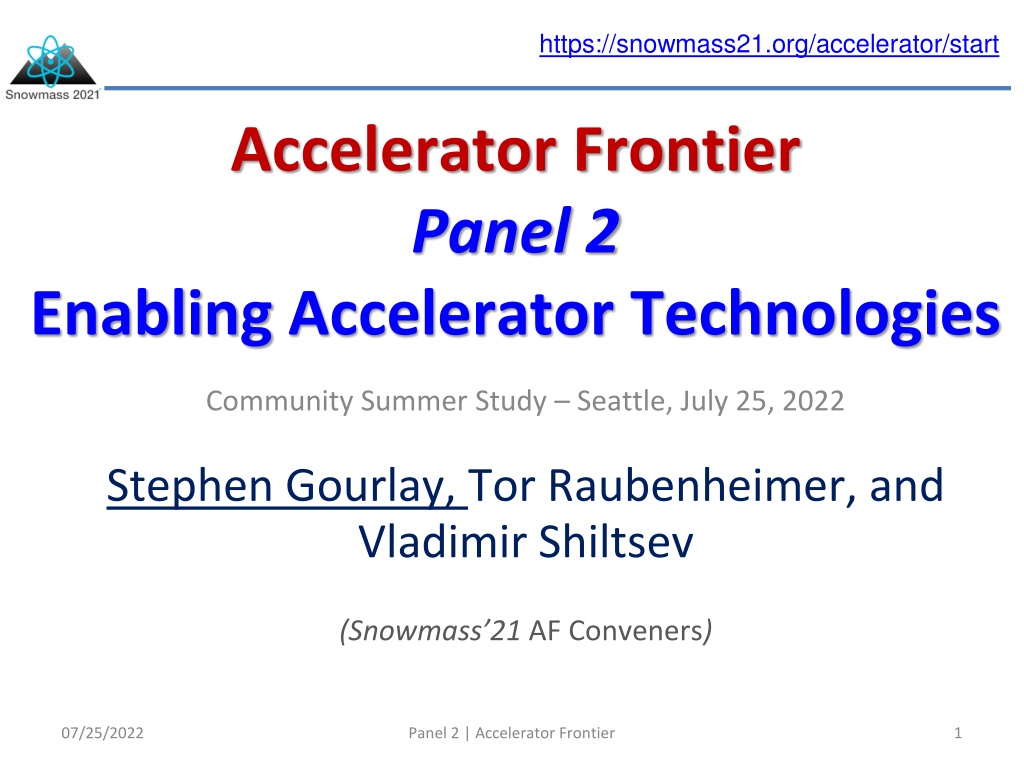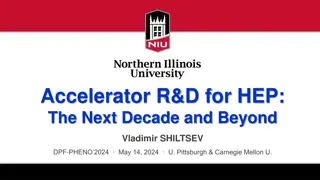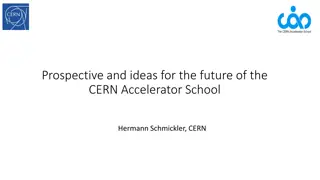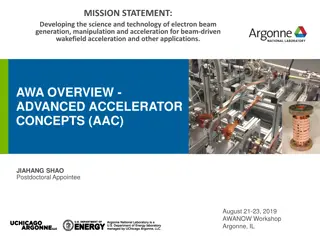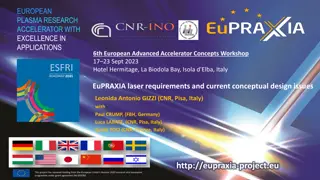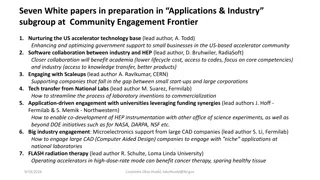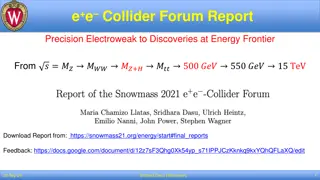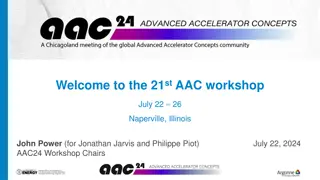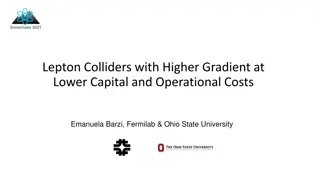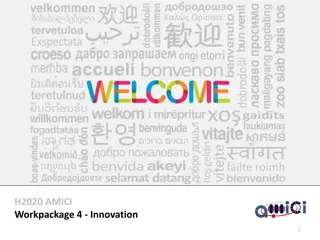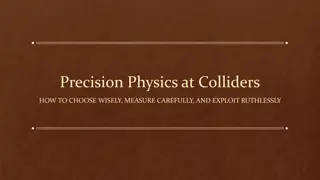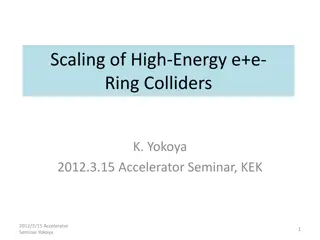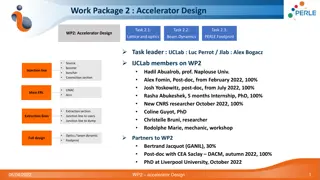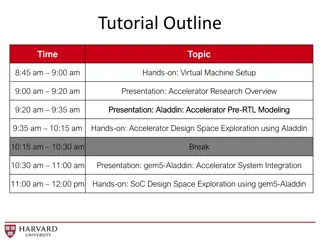Future of Accelerator Technologies: Enhancing Colliders and R&D Programs
The Accelerator Frontier Panel discusses the crucial components to enable future accelerators, emphasizing the need for a National Future Collider R&D Program, General Accelerator R&D, and adequate accelerator and test facilities. The message stresses the importance of an integrated future collider R&D program to tackle technical challenges and coordinate next-generation collider projects. Ongoing R&D efforts focus on fundamental beam physics, long-term accelerator concepts, and technologies essential for advancing facilities for neutrinos, rare processes, and colliders.
Download Presentation

Please find below an Image/Link to download the presentation.
The content on the website is provided AS IS for your information and personal use only. It may not be sold, licensed, or shared on other websites without obtaining consent from the author. Download presentation by click this link. If you encounter any issues during the download, it is possible that the publisher has removed the file from their server.
E N D
Presentation Transcript
https://snowmass21.org/accelerator/start Accelerator Frontier Panel 2 Enabling Accelerator Technologies Community Summer Study Seattle, July 25, 2022 Stephen Gourlay, Tor Raubenheimer, and Vladimir Shiltsev (Snowmass 21 AF Conveners) 07/25/2022 Panel 2 | Accelerator Frontier 1
To Enable Future Accelerators Three main components: To enable the near- to medium-term future: 1. A National Future Collider R&D Program To enable the medium- and long-term future: 2. General Accelerator R&D (GARD) 3. Accelerator and Test facilities 07/25/2022 Panel 2 | Accelerator Frontier 2
Accelerator Frontier Message On Colliders: We need an integrated future collider R&D program to engage in the design and to coordinate the development of the next generation collider projects: To address in an integrated fashion the technical challenges of promising future collider concepts that are not covered by the existing General Accelerator R&D (GARD) program. To enable synergistic U.S. engagement in ongoing global efforts (e.g., FCC, ILC, IMCC) To develop collider concepts and proposals for options feasible to be hosted in the U.S. (e.g., CCC, HELEN, Muon Collider, etc) 07/25/2022 Panel 2 | Accelerator Frontier 3
Accelerator Frontier Message On R&D: We have an ongoing R&D program aimed at fundamental beam physics and long-term accelerator concepts and technologies (RF, magnets, beam physics, advanced concepts, targets & sources, etc): All these items have broad applicability across future accelerators with ideas generated by Universities and labs R&D is key to enable facilities for neutrinos, rare processes and colliders 07/25/2022 Panel 2 | Accelerator Frontier 4
Accelerator R&D: Next Decade Magnets for Sources and Multi-MW targets: - intense e+sources - 2.4 MW for PIP-III - 4-8 MW for a muon collider Colliders and RCSs: - 16T dipoles - 40T solenoids - 1000 T/s fast cycling ones Accelerator & Beam Physics High intensity/brightness beams acceleration and control High performance computer modeling and AI/ML approaches Design integration and optimization, incl energy efficiency coordinated with US MDP Wakefields: - collider quality beams - efficient drivers and staging - close coordination with Int l (Euro Roadmap, EUPRAXIA,..) SC/NC RF: - 70-120 MV/m C3 - 70 MV/m TW SRF - new materials - high Q0 - efficient RF sources Panel 2 | Accelerator Frontier 5 07/25/2022
Accelerator and Test Facilities Enable technology progress and beam research Beam Physics Facilities SRF and SC Magnet Tests FNAL BNL ANL BNL FNAL LBNL SLAC Cornell CMT, Berkely, IOTA ring, Fermilab Wakefield/Plasma Studies MISSING PIECE! Facility for multi-MW beam targetry R&D and testing SLAC LBNL UT-Austin ANL UCLA FACET-II, SLAC, 07/25/2022 Panel 2 | Accelerator Frontier 6
Back up slides 07/25/2022 Panel 2 | Accelerator Frontier 7
Accelerator Frontier Message #5 #5 Accelerator development should be part of P5: Planning for accelerators should be aligned planning for particle physics and should be part of the P5 prioritization process. with the strategic 07/25/2022 Panel 2 | Accelerator Frontier 8
AF Message on Facilities (2) 3. in the area of future colliders - several approaches are identified as both promising and potentially feasible, and call for further exploration and support: in the Higgs/EW sector in addition to the ILC, there is growing support for the FCCee at CERN and somewhat more advanced linear colliders in the US, such as C3 and HELEN; 4. in the energy frontier, the discovery machines such as O(10 TeV c.m.e.) muon colliders have rapidly gained significant momentum: to be in a position for making choices and decisions on collider projects viable for construction in the 2040s and beyond at the time of the next Snowmass/P5, these concepts should be explored technically and documented inpre-CDR level reports 07/25/2022 by the end of this decade. Panel 2 | Accelerator Frontier 9
AF Message on Facilities (3) 5. Given that the U.S. HEP accelerator R&D portfolio presently contains no collider-specific scope we support proposal to establish integrated R&D program on future colliders in the DOE Office of High Energy Physics (OHEP) to carry- out technology R&D and accelerator design for future collider concepts: to address in an integrated fashion the technical challenges of promising future collider concepts, particularly those aspects of accelerator design, technology, and beam physics that are not covered by the existing General Accelerator R&D (GARD) program. to enable synergistic U.S. engagement in ongoing global efforts (e.g., FCC, ILC, IMCC) to develop collider concepts and proposals for options feasible to be hosted in the U.S. (e.g., CCC, HELEN, Muon Collider, etc) the U.S. national 07/25/2022 Panel 2 | Accelerator Frontier 10
AF R&D Message re: Technology Accelerator Technologies define cost per TeV and cost per MW, as well as performance limits (luminosity, power) R&D is a must. Targets and Sources (AF7-T&S): Clearly set priorities for the next years advanced neutrino target designs to secure operation at 2.4 MW beam power level (LBNF) Next step : 4-8 MW target concepts/R&D for a future Muon Collider Sources: high power high brightness e+ sources for future circular and LCs (incl. polarized) 07/25/2022 Panel 2 | Accelerator Frontier 11
AF R&D Message re: RF The only way to get particles accelerated RF systems need drastic reduction in cost and improvement in performance to support HEP aspirations (eg multi-TeV colliders) Priorities for the next decade (AF7-RF): Improve cavity performance (gradient, Q0~e11) Bring new materials like Nb3Sn to the level of Nb and beyond Better (more efficient, eg TW or CCC) structure designs, tunable RF for RCSs Effort on ERL coordinate with EIC and European roadmap 07/25/2022 Panel 2 | Accelerator Frontier 12
AF R&D Message re: Magnets Serious investment in both US, Europe, Japan, and, since recently, China. Impressive progress but long timeline. Priorities for the next decade (AF7-MAG): Explore Nb3Sn limit (16 T magnets, improve conductors) FCChh and MuC, in mind Toward HTS magnets for MuC (30 T solenoids) Strong need in cost efficient fast ramping magnets (1000 s T/s) for RCSs and MuCollider Coordinate US effort (MDP) with Europe (CERN) 07/25/2022 Panel 2 | Accelerator Frontier 13
AF R&D Message re: WFA Advanced Accelerator Concepts (AF6) show great progress in research (LPA/BPA FELs, record Gs, etc), but collider requirements are much more demanding esp. now when EF calls for 15 TeV cme lepton colliders It is expected that a plasma-based collider can only become available for particle physics experiments beyond 2050 (European strategy, 2021) In the US, next steps needed: establish coherent self-consistent parameter set of a WFA-based 15 TeV LC; experimental studies/facilities focused on beam quality and power efficiency 07/25/2022 Panel 2 | Accelerator Frontier 14
Accelerator Frontier Message #1 We have a broad array of accelerator technologies and expertise to design and construct prioritized HEP accelerator projects: short-term, mid-term and long-term. #2 We an ongoing R&D program aimed at fundamental beam physics and long-term level of accelerator concepts and technologies (SRF. SC magnets, Beam physics, etc) #3 We need an integrated future collider R&D program to engage in the design and coordinate the development of the next generation collider projects. 5. Given that the U.S. HEP accelerator R&D portfolio presently contains no collider-specific scope we support proposal to establish the U.S. national integrated R&D program on future colliders in the DOE Office of High Energy Physics (OHEP) to carry-out technology R&D and accelerator design for future collider concepts: to address in an integrated fashion the technical challenges of promising future collider concepts, particularly those aspects of accelerator design, technology, and beam physics that are not covered by the existing General Accelerator R&D (GARD) program. to enable synergistic U.S. engagement in ongoing global efforts (e.g., FCC, ILC, IMCC) to develop collider concepts and proposals for options feasible to be hosted in the U.S. (e.g., CCC, HELEN, Muon Collider, etc) 1. A multi-MW beam power upgrade of the Fermilab accelerator complex is the highest priority for the neutrino program in the 2030s corresponding accelerator technology and beam physics studies are needed to identify the most cost- and power-efficient solutions that could be timely implemented leading to breakthroughresults of the DUNE neutrino program; 2. several beam facilities for axion and DM searches are shown to have great potential for construction in the 2030s in terms of scientific output, cost and timeline incl. PAR (1 GeV, 100 kW PIP-II Accumulator Ring) 07/25/2022 Panel 2 | Accelerator Frontier 15
Accelerator Frontier Ask Next generation accelerators and colliders for discovery science push accelerator science towards ultimate performance with unprecedented beam energy, intensity, and brightness. Reduction of power consumption is one of the main challenges of future colliders. Long-term fundamental accelerator and beam physics research and development in Accelerator and Beam Physics is essential to meet these needs. The above items call for a substantial increase in corresponding R&D support, augmented with other measures to make the US competitive in education and attraction of accelerator talent, such as: creating an undergraduate level recruiting program structured to draw in women and underrepresented minorities (URM) that could be coordinated with the USPAS. re-establish a program of beam physics research on general collider related topics towards future e+e colliders and muon colliders strengthen and expand capabilities of the US accelerator beam test facilities to 07/25/2022 maintain their competitiveness with respect to worldwide capabilities Panel 2 | Accelerator Frontier 16
From the ITF Report Draft: Tables 1-3, 5 CME (TeV) Lumi per IP (10^34) Years, pre- project R&D Years to 1st physics Cost range (2021 B$) Electric Power (MW) 0.24 8.5 0-2 13-18 12-18 280 FCCee-0.24 0.25 2.7 0-2 <12 7-12 140 ILC-0.25 0.38 2.3 0-2 13-18 7-12 110 CLIC-0.38 0.25 1.4 5-10 13-18 7-12 110 HELEN-0.25 0.25 1.3 3-5 13-18 7-12 150 CCC-0.25 0.13 0.01 >10 19-24 4-7 ~200 MC-Higgs 3 5.9 3-5 19-24 18-30 ~550 CLIC-3 3 6.1 5-10 19-24 18-30 ~400 ILC-3 3 2.3 >10 19-24 7-12 ~230 MC-3 6-10 20 >10 19-24 12-18 O(300) MC-FNAL 10-14 20 >10 >25 12-18 O(300) MC-IMCC 100 30 Panel 2 | Accelerator Frontier >10 >25 30-50 ~560 07/25/2022 FCChh-100 17
